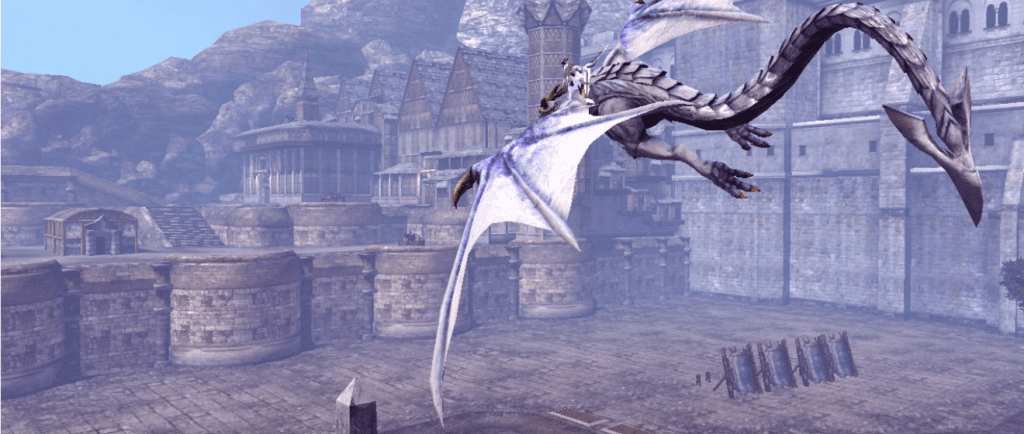I think most were surprised when we found out that the Drakengard games share an extended universe with the NieR games. It was an odd revelation; one that would be a bit more believable with some form of narrative-connecting bridge. With Drakengard set in a fantasy-fused version of the medieval past and NieR set in a dystopic future, perhaps something set in the present might help soften come confusion. Drakengard 3, however, has other ideas.
On This Page
Introduction
Drakengard 3 is an action role-playing video game developed by Access Games and published by Square Enix exclusively for the PlayStation 3. It is the third main game in the Drakengard series and also a prequel to the original game. The game, like the rest of the series, features a mixture of ground-based hack-and-slash combat and aerial battles. Where the previous two games featured intertwined stories and timelines, Drakengard 3 is set over 100 years before the first two games and features a new story based around a conflict between the world’s corrupt, self-serving divinity.
The game was created to cater for hardcore role-playing game audiences, and was developed largely by the same team who created the original Drakengard and NieR, including director Yoko Taro, producer Takamasa Shiba, and writer Sawako Natori. The music was composed by Keiichi Okabe, who also scored NieR. Unlike previous titles in the series, development was based at Access Games due to the company’s experience in developing action titles and the team’s wish to address criticisms laid at the somewhat sluggish gameplay of the previous Drakengard games.
While it received a physical and digital release in Japan and North America, Drakengard 3 was released in digital format only in Europe. This would prove problematic for a handful of European customers who pre-ordered the game before the physical release was cancelled as a select few retailers would attempt to honour the original orders by shipping copies of the game imported from North America to Europe. While the discs themselves are not region locked, their accompanying DLC is, meaning DLC content would be inaccessible to import players. This is one revelation I found out the hard way.

Story
Drakengard 3 takes place roughly one hundred years before the events of the first Drakengard game, acting as a prequel to the first two games in the series. Despite being a prequel, Drakengard 3 mostly follows a largely unrelated story which does not directly affect the events of Drakengard. The game is narrated to the player by Accord, an android created by the “old world” to monitor and document all timelines, while also introducing the player to the android race who would become the focus of the NieR games.
In earlier times, the land was ravaged by conflict between warlords. At the height of the carnage, six mysterious figures called Intoners appeared and using their ability to utilise magic through song, defeated the warlords and ended the conflict. Due to this, they became worshiped as deities and became rulers of various regions of the land. Each Intoner is known only by a numerical name.
An unspecified time later, in the game’s present, the strongest Intoner, One, wishes to unite the others once again and bring unity to the land. The source of the Intoners’ power is an evil magical flower, which Zero, the main protagonist and antihero, was saved from death to be used as an instrument for mankind’s destruction. Zero, the sixth Intoner, wishes to destroy all those affected by the flower’s corruptive influence, including her sisters and even herself.
The player controls Zero, who is now considered a traitor by the Intoners and their followers because of her mission to kill them. Aiding her in her quest is her dragon, who is her mount in aerial battles. The other five Intoners are: One, the current ruler of the Intoners; Two, the most cheerful member of the group and ruler of the Country of Sand; Three, ruler of the Country of Forest and an obsessive over dolls; Four, ruler of the Country of Mountains and pacifist who has taken a vow of chastity; and Five, ruler of the Country of Sea and a woman consumed by greed and lust.
Zero and her dragon Michael slaughter their way into the Cathedral City, the center of power for the Intoners. Zero’s attempt to kill them ends disastrously as she and Michael are gravely wounded by One’s own dragon, Gabriel. A year later, Zero and her dragon, now a childlike reincarnation named Mikhail, set off to try again. Travelling with Zero on her quest are the disciples, a group who formerly served the Intoners but are individually swayed into joining Zero’s cause.

Gameplay
Drakengard 3 features hack-and-slash gameplay and aerial combat on a dragon, as with previous entries in the series. The player controls the protagonist Zero during the campaign and for most levels is accompanied by up to two AI-controlled companions. In ground-based combat, Zero performs multiple attacks on various enemies. These can be combined into combos, which fill up Zero’s Tension Gauge. When the gauge is filled to any degree, Zero can temporarily enter ‘Intoner Mode’, a hyperactive state which enables her to move quickly and deal higher damage to enemies while also making her temporarily immune to incoming attacks.
As Zero levels up, her weapons grow more powerful and she gains access to additional weapon types as the game progresses. Each weapon type produces a different set of attacking moves. Unlike previous titles in the series, the player does not have to pause the games to switch weapons, instead being able to cycle weapon options at any time without pausing.
Zero can switch between four weapon types: swords, spears, combat bracers and chakrams. Each weapon has a four-level cap and can be leveled up either through combat or by spending money acquired during levels. Each weapon has different effects depending on enemy-type and combat situation, with spears being useful against armoured or shielded enemies and swords being a default ‘all-rounder’ weapon.
While exploring levels, Zero can collect items from chests and fallen enemies which earn money for buying consumables, as well as buying and leveling up weapons. Zero can also complete sidequests as the player progresses through the game. Sidequests take place within pocket areas of normal levels and place limitations on the Zero’s abilities. The player’s performance during these sidequests earns special items which increase in quantity based on your kill-count.
For aerial combat, Zero mounts her dragon Mikhail. The two main types of aerial combat are rail shooter-style missions and free-roaming combat which enables both aerial and ground-based combat. Mikhail has multiple attack types at his disposal. While on the ground, after Zero has mounted, Mikhail can perform a grand sweeping attack using his wings. In the air, Mikhail can breathe fire down onto the ground and at other airborne enemies.
Mikhail is fully controllable while in the air, flying through the environment and able to evade enemy fire. Mikhail’s main attack, breathing fire, features a lock-on feature which can target multiple enemies, in a nod to the iconic Panzer Dragoon series. Mikhail can also enter Intoner Mode while Zero is mounted, which magnifies the amount of damage he can deal. During ground-based missions, Zero can also call in Mikhail to deal damage to enemy units.

Graphics/Sound
Like its predecessors, Drakengard 3 isn’t terribly ambitious with its visuals. It’s easy to see elements of the series’ PS2 roots slipping through, particularly in the samey grey-brown environments and facial details which look quite a lot like Kingdom Hearts character models. Fortunately, Zero’s body animations counter this with elegant swordplay and a surprisingly graceful acrobatic flow.
The opening CGI cinematic does leave a strong first impression though and looks absolutely stunning, like a mini Square Enix animated movie. It was created by Visual Works. The scene was based on a storyboard produced by Yoko Taro, and director Kazuyuki Ikumori aimed to make the scene beautiful despite its gory content. Visual Works also handled the game’s in-game cutscenes.
Drakengard and NieR have always provided epic soundtracks of orchestral power-pieces which are often ominous at times and mysterious when it counts, and Drakengard 3 does not disappoint. The voice acting is also of a pleasingly high standard, with such veterans as Tara Platt, Kate Higgins, Christina Vee, Liam O’Brien, Cam Clarke, Yuri Lowenthal and Eden Riegel joining the crew.

Replayability/Trophies
The game is very linear, and a new chapter will appear each time you beat the previous one. There are no special requirements for completing up to Ending C, so just keep on playing as new chapters come up, visiting branching paths in the story which allow you to continue on after the initial credits roll from Ending A, then moving on to Ending B, and so on.
After you watch Ending C, there will be three extra chapters to complete before Route D is unlocked. However, even after it’s unlocked, you won’t be able to access it until you obtain every single weapon in the game. At the very end of Ending D, there will be hell waiting for you in the form of a rhythmic mini-game, and this is where the real challenge begins and many playthroughs end. Before you give up (and you will consider it) maybe try playing along to a video playthrough guide. It was an absolute godsend for me.
Following that, trophy hunters may want to tie up loose ends and finish the sidequests. Some sidequests are ridiculously difficult, but become simple once you completely upgrade all your weapons. The reason for this is upgrade completion will unlock one of Zero’s most powerful costumes which will grant you unlimited Intoner Mode. Thankfully, upgrades are done by using gold instead of enemy drops, but you do need ridiculous amounts of gold to buy everything. Be prepared to farm for a good few hours.

Conclusion
What surprised me the most about Drakengard 3 is just how incredibly mature it is for a Square Enix title. It’s certainly graphic, with buckets of visceral blood splatter and mutilation, but you tend to find most aged gamers have become desensitised to heavy violence and gore anyway. What may be more surprising are the frequently used sexual references in the party banter. While there isn’t any nudity in the game (which actually wouldn’t be terribly out of place) most of the disciples and the Intoners themselves, including Zero, are pretty quick to brag about their sexual conquests and desires, and will do so often.
For all of its quirks, Drakengard 3 still manages to tell a compelling story through its branching timelines and scattered episodes which opens up the game more than one might expect after your first linear playthrough. While it’s not exactly a bridge between Drakengard and NieR, there are little references here and there to the origins of certain elements from both, which is pleasingly rewarding to see.
You will need to put in a few extra hours to experience every component of this fragmented story, and while some of the requirements to do so can be both odd and cumbersome, such as finding every weapon in the game and beating the brutal true final boss, they are all pieces of a grander puzzle that comes together completely when you’re done, and it’s immensely satisfying.
Joys
- A fascinating story of many intricate parts and branches
- Zero is a cool, anti-hero-type protagonist with plenty of style and sass
- Top-notch soundtrack and voice acting
Cons
- It looks like an upscaled PS2 game at times
- The difficulty spike of the true final boss is a whole new level of frustrating
- Finishing everything will require a hefty amount of dedication and grinding



